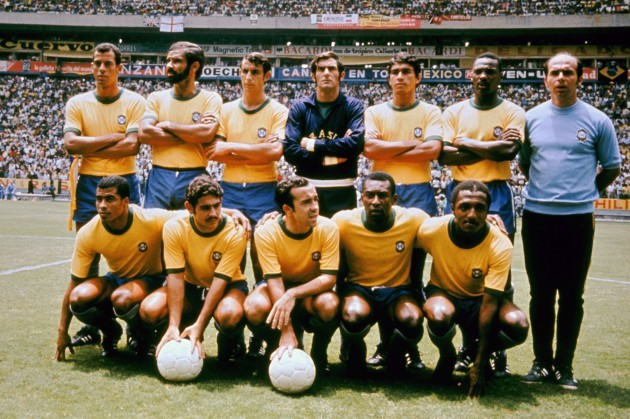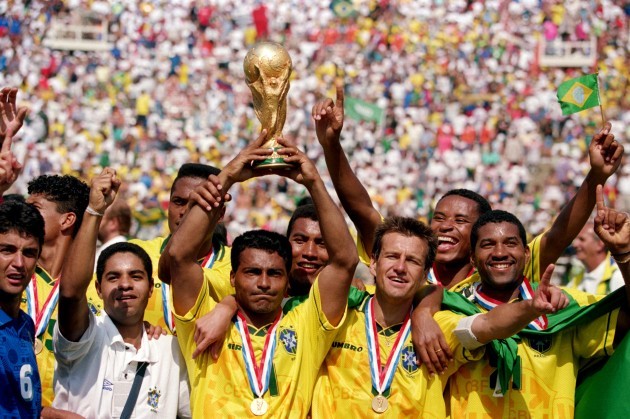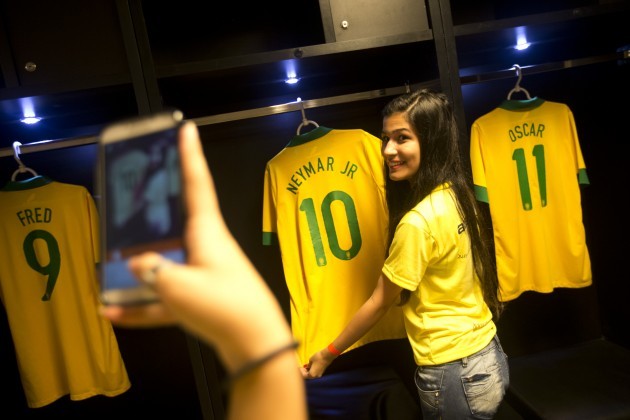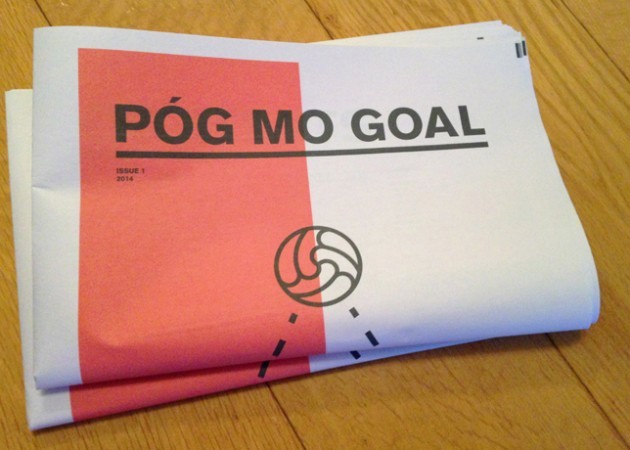KNOWN AS ‘O Canarinho’ The Little Canary, it is one of the most iconic images in sport.
Yellow flashing with blue on bronzed skin, dancing, darting, with a ball moving like paint strokes. Zig-zags, turns, pass, pass pass. Brazil. The cradle of football. Movers. Masters.
The jersey of the Selecao epitomises soccer and the World Cup, and when the tournament kicks off in Sao Paulo on June 12, millions will wear the beloved shirt in a nation besotted with the beautiful game. And yet, the garment wouldn’t exist – certainly not in its current form – without the devastation of Brazil’s loss in the 1950 World Cup final and the subsequent imagination of a 19-year-old from the city of Pelotas.
Brazil is the most successful team in football history with five World Cup titles, four Confederations Cup wins, including the most recent in 2013, and is the only country to feature at every World Cup. As an emblem of the nation, the yellow shirt of the football team has few equals, matching the statue of Cristo Redentor that stands guard over the city of Rio de Janeiro.
Below, each evening the beaches play host to scores of Cariocas working a football through the sands towards the wooden goalposts that stand permanently along the coastlines of Ipanema and Copacabana, and the parks around this metropolis that also houses the famous Maracana stadium. It’s a scene repeated all over this land of almost 200 million people.
If England gave football to the world, the Brazilian world is given over to football. It’s generally accepted that Brazil’s first ‘international’ game took place in 1914 involving a Rio de Janeiro/Sao Paulo selection taking on English side Exeter City. Squabbling between the authorities in both these states would stifle early squads as internal politics within Brazilian football hindered the development of the national team. The country struggled to make an impression in the infant editions of the World Cup, a competition that would come to define its nationalism.
At the 1930 tournament in neighbouring Uruguay, Brazil were drawn in a group alongside Bolivia and Yugoslavia. In their first ever World Cup game, they were defeated 2-1 by the Yugoslavs. Despite beating Bolivia 4-0 in the second match, Brazil failed to advance to the second round and were out. The bad blood between Sao Paulo and Rio continued to infect the national team and the poor showing was generally blamed on the rivalry between the states. Some reports suggested Sao Paulo officials were prevented from travelling to Uruguay, and in retaliation the Paulista clubs refused to release their players.
Four years later, Brazil travelled by boat to Italy, and in a knock-out format, were eliminated after one game, losing 3-1 to Spain. This time, the growing debate between professionalism and amateurism that was bubbling in Brazilian football seeped out in the fall-out from the tournament. This argument would play its part in the reform of the Brazilian football federation after the 1950 competition on home soil, from which the iconic ‘Canarinho’ would emerge.
Things were looking up when Brazil finished third in the 1938 edition with Leonidas da Silva, who some credit with popularising the bicycle kick, earning the accolade of top scorer. The 1942 and 1946 competitions, which Nazi Germany and Brazil sought to host, were cancelled due to the outbreak of World War II in which thousands of Brazilians were sent to Europe to fight alongside the Allied Forces.
The World Cup recommenced in 1950 finally coming to Brazil. Five of the host’s matches at the tournament were played at the Maracana, including the final where they suffered a shock 2-1 defeat to Uruguay in front of an official attendance of 174,000. The actual figure was said to be well over 200,000 and at the time, the Maracana was the biggest stadium in the world, surpassing Hampden Park in Glasgow. With the latter stages of the tournament played on a group basis, the Selecáo only required a draw in the final to become World Champions on home soil.
Brazil took the lead through Friaca but Uruguay came storming back. Juan Schiaffino equalised before Alcides Ghiggia scored with just 11 minutes to go to stun the home crowd and clinch the trophy The game would come to be known in Brazilian footballing folklore as the Maracanazo – the Maracana blow. Decades later Ghiggia remarked: “Only three people in history have managed to silence the Maracana, the Pope, Frank Sinatra and me”. In 2009, Brazil paid tribute to Ghiggia for his role in the game by having his footprints cast in a special pavement at the stadium.
Humiliation
The defeat to Uruguay was regarded as a national humiliation. Newspapers had carried headlines of ‘Campeoes’ prior to the game with victory parades already planned. Some say the country has never gotten over the defeat with the sorry tale of the vilification of goalkeeper Moacir Barbosa becoming one of Brazilian football’s most shameful episodes. Others claim it was the reason for the exclusion of black players from the national team for a time afterwards.
The fall-out from the tournament caused deep soul-searching in Brazilian football. Part of that process deemed the team’s first colours of white shirts with blue collars as unreflective of a growing patriotism. With permission from the Brazilian Sports Confederation, the newspaper Correio da Manhã held a competition to design a new kit incorporating the four colours of the national flag.
In the town of Pelota near the border with Uruguay, nineteen-year-old Aldyr Garcia Schlee was working as a newspaper illustrator. He submitted a design of a yellow jersey with green detailing, blue shorts and white socks. Out of another 300 entries, Schlee’s was chosen as the winner. The new colours were worn for the first time in March 1954 in a match against Chile.
Years later, Schlee recalled a presentation when the strip was worn for the first time by a player. Five footballers from clubs in Rio were present including Zizinho, who, Schlee recounted, gently took him by the arm, leaned in, smiled and said quietly: “This is all shit”.
Schlee went on to become a leading academic who suffered at the hands of the military following the coup in 1964 and was imprisoned on several occasions. It’s deeply ironic that Schlee should fall out of love with football and the capitalism that has come to infect it given that his design became possibly the most famous emblem of his country and has changed little up to the present day.
It was the 1970 World Cup that saw, for the first time, a global television audience exposed to the mesmerising sight of players such as Pelé, Jairzinho, Tostao, and Rivelinho in colour. The captivating movement, fluid control, and rhythm of the team has since seen them become regarded as the greatest of all time. Enveloping all the magic was the glorious technicolour yellow shirts, blue shorts, white socks and black boots stroking what seemed like an oversized ball.
Black and white panels moving in patterns, as impossibly tanned legs in a blaze of blue, yellow, white, and green, connected and communicated with each other as if dancing. The team came to be known as the Boys from Brazil but the famous names and faces, amongst the most celebrated in the history of sport, are rendered all the more meaningful by the imagery, the colours, the noise.
Today the yellow shirt of Brazil is as likely to be found on the astroturf pitches of Dublin as the beaches of Rio de Janeiro. In 1954, it became a symbol of national identity. Now it’s also a symbol of sporting excellence, but more than that, the beauty of the beautiful game itself.
James Carew is co-editor of the Póg Mo Goal magazine, the new Irish football publication focused on quality writing and considered design, available in Indigo and Cloth in Temple Bar and online pogmogoalmagazine.com




